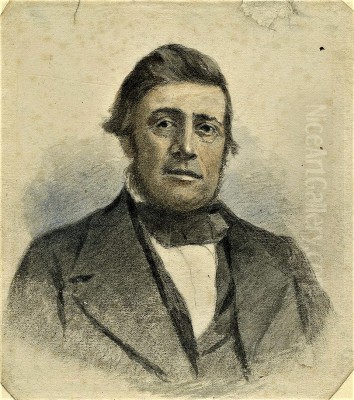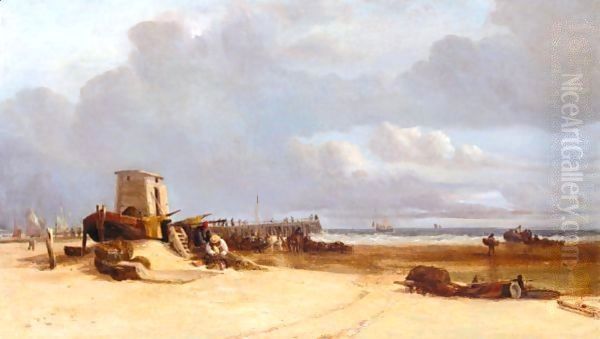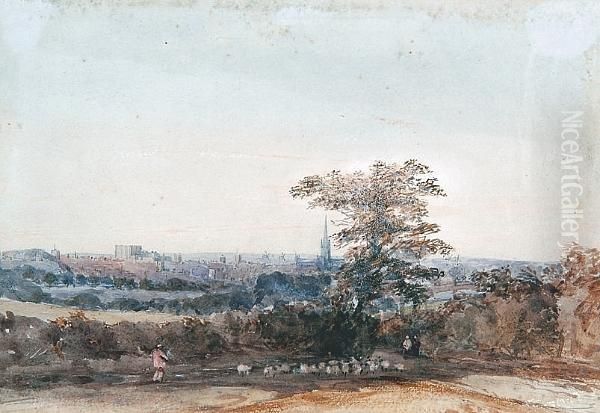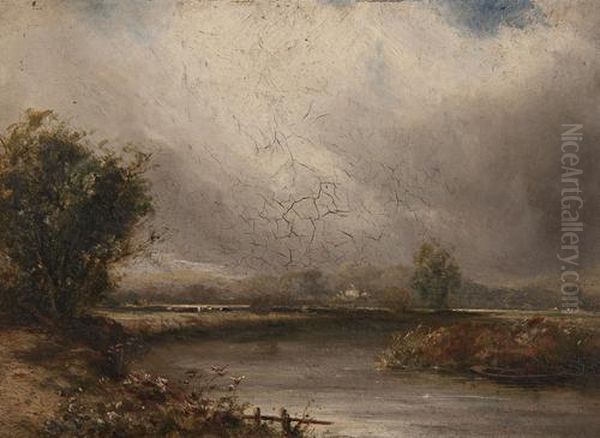
Thomas Lound (1801–1861) stands as a significant, if sometimes overlooked, figure within the celebrated Norwich School of painters. An accomplished amateur artist whose professional life was rooted in a brewing business, Lound dedicated his considerable talents to capturing the landscapes and waterways of his native Norfolk and beyond. His work, primarily in watercolour but also encompassing oils and etchings, reflects the core tenets of the Norwich School: a deep appreciation for nature, a commitment to direct observation, and a subtle, often poetic, rendering of light and atmosphere. While his fame may have been eclipsed by the school's towering figures, John Crome and John Sell Cotman, Lound's contribution remains vital to understanding the breadth and depth of this pioneering English art movement.
Early Life and Artistic Awakening in Norwich
Born in 1801, Thomas Lound grew up in Norwich during a period of remarkable artistic ferment. The city, a prosperous regional capital, was fostering a unique cultural environment that would give rise to the first provincial art movement in Britain. Lound's family was involved in the brewing trade, a business he would eventually join and manage. However, from an early age, he displayed a keen interest and aptitude for art. This passion was likely nurtured by the city's burgeoning artistic community and the presence of influential figures who were shaping a new vision for landscape painting.
The Norwich of Lound's youth was alive with artistic discussion and practice. The formation of the Norwich Society of Artists in 1803 by John Crome and Robert Ladbrooke provided a crucial platform for local artists to exhibit their work, exchange ideas, and cultivate a distinct regional identity in art. This society, which held annual exhibitions from 1805, became the focal point for what would later be known as the Norwich School. It was in this stimulating environment that Lound's artistic sensibilities were honed.
The Norwich School of Painters: A Provincial Renaissance

To fully appreciate Thomas Lound's artistic journey, one must understand the context of the Norwich School. This group of self-taught or locally trained artists, active primarily in the first half of the 19th century, drew their inspiration from the distinctive Norfolk landscape – its broads, rivers, coastline, and rustic architecture. They were profoundly influenced by the Dutch Golden Age landscape painters, such as Meindert Hobbema and Jacob van Ruisdael, whose works they studied in local collections. This influence manifested in a preference for naturalism, careful attention to detail, and an emphasis on the effects of light and weather.
John Crome (1768–1821), often referred to as "Old Crome," was the spiritual father of the school. A largely self-taught artist of humble origins, Crome instilled in his followers a deep respect for the direct observation of nature. His motto, "dignity, grandeur, and sentiment," guided his approach to landscape, which combined meticulous detail with a profound sense of place. His works, such as "The Poringland Oak" or "Moonrise on the Yare," exemplify the school's early character.
John Sell Cotman (1782–1842) was the other dominant figure of the Norwich School. Cotman's style was more varied and experimental than Crome's. He was a master of watercolour, known for his bold, flat washes, simplified forms, and exquisite sense of design, as seen in works like "Greta Bridge." His influence, particularly on the younger generation of Norwich artists, including Lound, was considerable. Cotman's sophisticated compositions and innovative watercolour techniques pushed the boundaries of landscape art.
Other key members who formed the vibrant milieu in which Lound developed included James Stark (1794–1859), a pupil of Crome, known for his detailed and often idyllic woodland scenes. George Vincent (1796–c.1832), another Crome pupil, painted expansive views of Norfolk and Scottish scenery, often with dramatic skies. Joseph Stannard (1797–1830) excelled in marine subjects and depictions of river life, bringing a fresh, breezy quality to his work. His brother, Alfred Stannard (1806-1889), and Alfred's daughter, Eloise Harriet Stannard (1829-1915), though known more for still life, were also part of this artistic lineage.
John Thirtle (1777–1839), a contemporary of Lound and a close friend, was a highly accomplished watercolourist, particularly admired for his atmospheric river scenes and depictions of Norwich. Henry Ninham (1793–1874), an engraver and painter, meticulously documented the architectural heritage of Norwich. Further figures associated with the school include John Berney Crome (1793–1842), son of John Crome, who continued his father's landscape tradition, and Miles Edmund Cotman (1810–1858), son of John Sell Cotman, who became a skilled marine painter and drawing master. Artists like David Hodgson (1798-1864), Robert Ladbrooke (1768-1842), and John Middleton (1827-1856) also contributed to the richness of the school.
Lound's Artistic Development and Style

Thomas Lound, while an amateur in the sense that art was not his primary profession, was a dedicated and prolific painter. He absorbed the influences of both Crome and Cotman, yet developed a distinctive style of his own. He was particularly drawn to watercolour, a medium in which he excelled, producing works characterized by their freshness, spontaneity, and delicate handling of light. His watercolours often display a clarity and directness reminiscent of the early English watercolourists, but with a sensitivity to atmosphere that was a hallmark of the Norwich School.
Lound was a keen observer of nature, and his sketchbooks were filled with studies made directly from life during his excursions through Norfolk, as well as trips further afield to Wales, Yorkshire, and other parts of Britain. These plein air sketches often formed the basis for more finished studio works. His technique in watercolour involved fluid washes, often combined with precise penwork or delicate brushstrokes to define forms and textures. He had a particular skill for capturing the reflective qualities of water and the subtle gradations of colour in skies and foliage.
While watercolour was his preferred medium, Lound also worked in oils. His oil paintings, though less numerous, demonstrate a similar commitment to naturalism and a fine sense of composition. He also experimented with etching, producing a number of plates that show his facility with line and his ability to translate the textures and tones of the landscape into a graphic medium. His etchings often depict rustic scenes, boats, and architectural details, sharing thematic concerns with his paintings.
Subject Matter and Representative Works
Lound's subject matter was diverse, though firmly rooted in the landscape tradition. He painted the rivers and broads of Norfolk, the bustling quaysides of Yarmouth and Norwich, ancient churches, crumbling abbeys, and quiet rural lanes. His works often convey a sense of tranquility and a deep affection for the places he depicted.
Among his notable works, "The River Wensum at Norwich" showcases his ability to capture the interplay of light on water and the picturesque charm of the city's riverbanks. "Yarmouth Jetty" is another fine example of his marine painting, depicting the lively activity of the coast with a keen eye for detail and atmospheric effect. His studies of architectural subjects, such as "Ruins of St. Benet's Abbey," demonstrate his skill in rendering texture and form, as well as his romantic sensibility.

Lound was also an avid collector of art and a copyist. He is known to have copied works by other artists he admired, including John Sell Cotman and the renowned British watercolourist David Cox (1783–1859). This practice was not uncommon at the time and served as a valuable means of study and technical development. His admiration for Cox is evident in some of his more freely handled watercolours, which share Cox's vigorous brushwork and emphasis on capturing the fleeting effects of weather.
Lound's Role and Interactions within the Norwich School
Thomas Lound was an active participant in the Norwich art scene. He exhibited regularly with the Norwich Society of Artists from 1820 until its dissolution in 1833, and later with its successor, the Norfolk and Norwich Art Union. His home in King Street, Norwich, became a meeting place for fellow artists, and he was known for his generosity and enthusiasm in supporting the local artistic community.
He maintained close friendships with several members of the Norwich School. His association with John Thirtle was particularly strong, and the two artists likely influenced each other's work. Lound also had connections with James Stark and George Vincent, sharing their commitment to depicting the local scenery. He was a known admirer and collector of John Sell Cotman's work, and Cotman's stylistic innovations undoubtedly left a mark on Lound's own artistic practice.
Lound's position as a successful businessman allowed him a degree of financial independence that perhaps afforded him greater freedom in his artistic pursuits than some of his professional contemporaries. He painted for the love of it, and this passion is evident in the sincerity and freshness of his work. He was also a patron, acquiring works by his fellow Norwich artists and building a significant personal collection.
Exhibitions and Contemporary Recognition
Beyond Norwich, Lound also sought recognition on a national stage. He exhibited a small number of works at the Royal Academy in London and at the British Institution. While he may not have achieved the widespread fame of some of his peers, his talent was recognized by those within the Norwich circle and by discerning collectors. His works were appreciated for their truthfulness to nature, their technical skill, and their charming depiction of local scenery.
The exhibitions of the Norwich Society of Artists were crucial for Lound and his contemporaries. They provided a vital outlet for their work, fostering a sense of shared purpose and encouraging a high standard of artistic production. These annual shows attracted considerable local interest and helped to establish Norwich as an important centre for landscape painting in Britain, rivaling even some of the activities in London at the time. The critical reception of these exhibitions, often reported in local newspapers, provides valuable insights into how the work of Lound and his fellow artists was perceived by their contemporaries.
Later Years and Enduring Legacy
Thomas Lound continued to paint throughout his life, his passion for art undiminished. He remained a respected figure in Norwich, known for both his business acumen and his artistic talents. He passed away in Norwich on January 29, 1861, leaving behind a substantial body of work that attests to his dedication and skill.
In the decades following his death, the Norwich School as a whole experienced periods of fluctuating critical fortune. However, the late 19th and early 20th centuries saw a revival of interest in the school, with scholars and collectors recognizing its unique contribution to British art. Figures like John Crome and John Sell Cotman were rightfully elevated to the pantheon of great British landscape painters. While artists like Thomas Lound did not achieve the same level of posthumous fame, their work has been increasingly appreciated for its intrinsic quality and its importance in representing the full spectrum of the Norwich School's achievements.
Today, Thomas Lound's paintings and watercolours are held in numerous public collections, including the Norwich Castle Museum & Art Gallery, which has an extensive collection of Norwich School works, as well as the British Museum and the Victoria and Albert Museum in London. His art continues to charm viewers with its honesty, its technical finesse, and its affectionate portrayal of the English landscape. He stands as a testament to the rich artistic talent that flourished in Norwich in the early 19th century, a dedicated amateur who made a professional-level contribution to one of Britain's most significant art movements. His work reminds us that artistic significance is not solely measured by fame, but also by the skill, passion, and vision an artist brings to their craft. Lound, alongside his contemporaries like the aforementioned Stark, Vincent, Thirtle, Ninham, and the Stannards, as well as figures like John Crome's son John Berney Crome and Cotman's son Miles Edmund Cotman, helped create a lasting legacy that continues to inspire. The influence of earlier masters like Richard Wilson or Thomas Gainsborough on the broader British landscape tradition also provided a backdrop against which the Norwich School's specific local focus shone.
Conclusion: A Quiet Contributor to a Vibrant School
Thomas Lound's life and art offer a fascinating glimpse into the world of a dedicated amateur painter operating within a major provincial art movement. His brewing business provided him with a stable livelihood, but his true passion lay in capturing the beauty of the world around him through his watercolours, oils, and etchings. As a key member of the later phase of the Norwich School, he absorbed the influences of its founders, Crome and Cotman, and developed a personal style characterized by sensitivity, freshness, and a deep connection to his subject matter.
While often overshadowed by the more celebrated names of the Norwich School, Lound's contribution was significant. He was not only a prolific and skilled artist in his own right but also a supportive member of the Norwich artistic community, a collector, and a friend to many of his fellow painters. His work enriches our understanding of the Norwich School, demonstrating the depth of talent that existed beyond its leading figures. Thomas Lound's legacy is that of an artist who, with quiet dedication and considerable skill, beautifully chronicled the landscapes and waterways of his beloved Norfolk, leaving behind a body of work that continues to delight and impress. His art serves as a vital part of the narrative of British landscape painting in the 19th century, a testament to the enduring power of place and the artistic vision it can inspire.